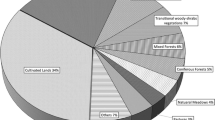Abstract
A review of agroforestry practices in one lowland and one highland community of Xishuangbanna [Yunnan, P.R. China] has been carried out. Multilayer homegardens and taungya for fuelwood in the lowlands, tea shaded by natural forest and shellac production in a swidden farming system in the highlands are described. The extention of these agroforestry systems in Xishuangbanna is analyzed.
Farming systems are facing problems related to shifting cultivation and to a rapid development of rubber which induce a negative evolution of these agroforestry systems.
New agroforestry patterns based on Chinese research work, with rubber trees or with shade medicinal plants, are in extension in villages and in state farms.
Résumé
Un inventaire des systèmes agroforestiers du Xishuangbanna [Yunnan, R.P. Chine] a été réalisé: jardins à plusieurs étages et production de bois feu par système de taungya dans un village de plaine, thé à l'ombre de forêt naturelle et production de gomme-lacque dans un système d'agriculture sur brûlis dans un village de montagne.
Les systèmes de production sont confrontés aux problèmes liés à l'agriculture sur brûlis, et au développement de l'hévéa. Il en résulte des évolutions négatives de ces practiques agroforestières.
De nouveaux modèles agroforestiers, à base d'hévéa ou de plantes médicinales d'ombre, se développent dans les villages et dans les fermes d'état á la suite des travaux de la recherche chinoise.
Similar content being viewed by others
References
Chong Yinong (1989) Paulownia, the rediscovery of China's ‘magic tree’. Agroforestry Today 1(1): 19–20
Feng Yaozong (1980) Research on rubber and tea plant communities. Tropical Plants Research 14: 1–74 (in Chinese)
He Kang editor (1988) China agricultural yearbook 1987. Agricultural Publishing House, Beijing
Huang Zongdao (1980) Assessment of rubber planting areas in tropical and subtropical zones of China. Chinese Journal of Tropical Crops 1(1): 2–15 (in Chinese)
Huguet L (1980) L'association de l'agriculture et de la forêt dans la Chine agricole. Bois et forêts des tropiques 189: 3–29
Liu Xunhao and Han Xianglin (1987) Multiple cropping systems in China. Beijing University of Agriculture Publishing House, 183 pp (in Chinese)
NFTA (1982) Resource documents on nitrogen-fixing trees. Published by Nitrogen-Fixing Trees Association, Hawaii
Ou Bingrong and Hong Guangji (1984) The shellac insect. In: Zhu Guokai (ed) Economic Insects: 174–214. Science Publishing House, Beijing
Ou Bingrong and Hong Guangji (1990) Description of a new species of Kerria in Yunnan province. Entomotaxonomia 12(1): 15–18
Pei Shengji (1985) Some effects of the Dai people's cultural beliefs and practices upon the plant environment in Xishuangbanna. University of Michigan Annals of Botany 27: 321–339
Pei Shengji (1986) Using ethnoecology to study swidden cultivation in the tropical area of southern Yunnan. Tropical Plants Research 29–30: 1–7 (in Chinese)
Whitmore TC (1982) Fleeting impressions of some chinese rain forests. Commonwealth Forestry Review 61(1): 51–58
Xu Zaifu (1987) From shifting cultivation to agroforestry, a tendancy of agricultural development in the mountain areas of Yunnan tropics. Proceedings of a Workshop on Forest and Farming Fields in Tropical Asia, Kunning, November 1987
Yin Shaoting (1988) Ethnoecology of Jinuo shifting cultivation. Agricultural Archaeology 1988(1): 318–334 and 1988(2): 390–408 (in Chinese)
Yoshimo M (1988) Climates, geoecology and agriculture in tropical China, volume 2. Climatological notes, 38. University of Tsukuba. 301 pp
Yu Pinghua (1982) A research on the ethnical timber utilization in Xishuangbanna. In: Yunnan Institute of Botany (ed) Collected papers on tropical botany. Yunnan People Publishing House, Kunming (in Chinese)
Yu Pinghua (1985) Traditional cultivated plants in Dai villages of Xishuangbanna. Acta Botanica Yunnanica 7(2): 169–186 (in Chinese)
Yunnan Minorities Editing House (1985) An introduction to minorities' autonomous areas in Yunnan. Yunnan Minorities Editing House, Kunming. 186 pp (in Chinese)
Zheng Xiaoyun (1985) Issues of development of market economy in the Jinuo mountains. Ethnology and Modernization 1985 (2): 24–27
Zhu Zizhen and Tang Rongnan (1985) Historical perspective of traditional ecosystems in tea plantations. Agricultural Archeology 1985(1): 203–209 (in Chinese)
Author information
Authors and Affiliations
Rights and permissions
About this article
Cite this article
Saint-Pierre, C. Evolution of agroforestry in the Xishuangbanna region of tropical China. Agroforest Syst 13, 159–176 (1991). https://doi.org/10.1007/BF00140239
Issue Date:
DOI: https://doi.org/10.1007/BF00140239



